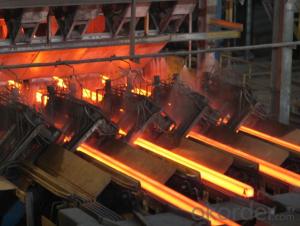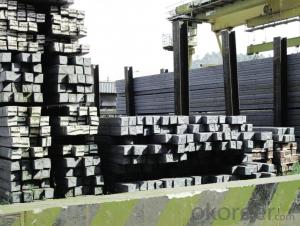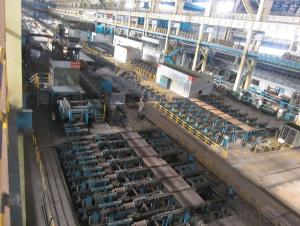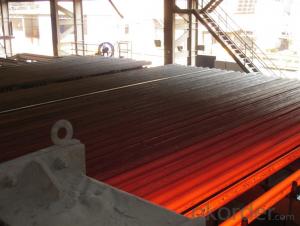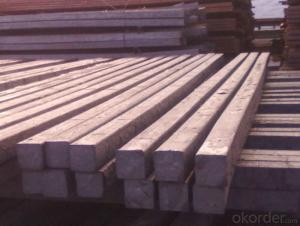Prime quality prepainted galvanized steel 670mm
- Loading Port:
- Tianjin
- Payment Terms:
- TT OR LC
- Min Order Qty:
- 100 m.t.
- Supply Capability:
- 10000 m.t./month
OKorder Service Pledge
OKorder Financial Service
You Might Also Like
Construction building material galvanized color prepainted cold
rolled steel coil
Prepainted steel sheet is coated with organic layer, which provides higher anti-corrosion property and
a longer lifespan than that of galvanized steel sheets.
The base metals for prepainted steel sheet consist of cold-rolled, HDG electro-galvanized and hot-dip
Alu-zinc coated. The finish coats of prepainted steel sheets can be classified into groups as follows:
polyester, silicon modified polyesters, polyvinylidene fluoride, high-durability polyester, etc
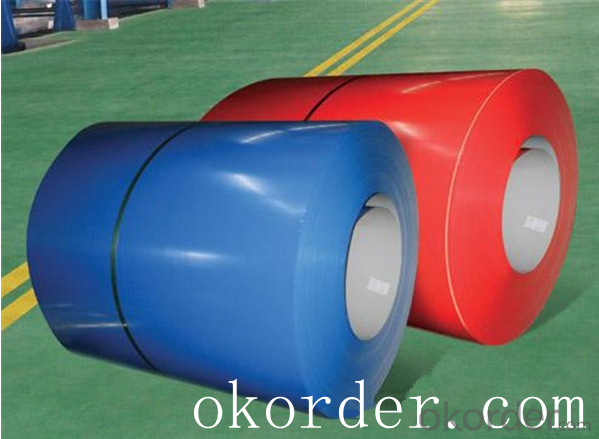
Standard and Grade :
Pre-paint galvanized steel coil | ||||
ASTM A755M-03 | EN10169:2006 | JISG 3312-2012 | ||
Commercial quality | CS | DX51D+Z | CGCC | |
Structure steel | SS GRADE 230 | S220GD+Z | CGC340 | |
SS GRADE 255 | S250GD+Z | CGC400 | ||
SS GRADE 275 | S280GD+Z | CGC440 | ||
SS GRADE 340 | S320GD+Z | CGC490 | ||
SS GRADE550 | S350GD+Z | CGC570 | ||
S550GD+Z | ||||
Application:
Outdoor | Roof, roof structure, surface sheet of balcony, frame of window, door of garage, rolled shutter door, booth, Persian blinds, cabana, etc |
Indoor | Door, isolater, frame of door, light steel structure of house, home electronic appliances, ect. |
Specifications
Commodity Name: Prepainted Galvanized Steel Coil
Standard: AISI, ASTM, DIN, GB, JIS
Grade: TDC52D+Z
Thickness 0.13-8.0mm
Width:600mm-1350mm
Zinc Coating:275g/m2
Polyester Coating Thickness:Top and Back coating thickness depend by Buyer Requirement.
Polyester Coating Type:2/2,1/2m,1/2.
Polyester Type: Polyester, silicone modified polyester, high durability polyester (HDP), polyvinylidene fluoride (PVDF)
Unit Roll Weight:5-20tons
Place of Origin Shanghai , China (Mainland)
Surface Treatment :Color Coated
Manufacture Progress:HRC-CRC-GALVANIZED-COLOR COATED
Application : Construction, electrical, transportation, steel plant, composite board plant, steel tile factory
Payment & Shipping Terms:T/T ,L/C, and FOB CHINA
Minimum Order Quantity: 25Tons
Packge Type: Moisture-proof paper inner,Steel outside,Bundle by steel rope.
Package in Container : Wood as a foot pad, wire rope reinforcement,PPGI steel coil tied together by steel rope.
- Q:How are steel billets used in the automotive industry?
- Steel billets are an essential component in the automotive industry and are used in various applications due to their strength, durability, and versatility. These billets are primarily used to manufacture various parts and components of automobiles, ranging from chassis and engine parts to suspension systems and body panels. One of the key uses of steel billets in the automotive industry is in the production of crankshafts, which are crucial for converting the reciprocating motion of pistons into rotational motion. Crankshafts need to withstand high levels of stress and pressure, and steel billets provide the necessary strength and resilience to meet these requirements. Similarly, steel billets are used to manufacture camshafts, which control the opening and closing of the engine's valves. Camshafts require high precision and durability to withstand the continuous mechanical stresses, and steel billets offer the necessary mechanical properties to ensure their reliability. Furthermore, steel billets are commonly employed in the production of various suspension components, such as control arms and axle shafts. These components need to withstand heavy loads and shocks while maintaining structural integrity, making steel billets an ideal material choice. In addition, steel billets are utilized in the manufacturing of body panels, such as doors, hoods, and fenders. These parts require high strength to ensure passenger safety and withstand impacts, and steel billets provide the necessary strength while also offering cost-effectiveness. Moreover, steel billets are used in the production of transmission components, including gears and shafts. These parts require high strength, wear resistance, and dimensional accuracy, which are all provided by steel billets. Overall, steel billets play a crucial role in the automotive industry, enabling the production of various components and parts that require exceptional strength, durability, and precision.
- Q:What are the main differences between hot-rolled and cold-rolled steel billets?
- The main differences between hot-rolled and cold-rolled steel billets lie in the manufacturing process and the resulting characteristics of the steel. Hot-rolled steel billets are produced by heating the steel above its recrystallization temperature, typically around 1200°C (2200°F), and then rolling it into the desired shape or size. This process involves the use of large-scale machinery, such as rolling mills, which apply significant pressure to shape the steel. As a result, hot-rolled steel billets have a characteristic rough and scaled surface. On the other hand, cold-rolled steel billets are produced by further processing the hot-rolled steel. The hot-rolled steel is first cooled down to room temperature and then passed through a series of rollers at lower temperatures, typically below 1000°C (1832°F). This process provides more precise control over the dimensions and surface finish of the steel. Cold-rolled steel billets have a smoother and more polished appearance compared to their hot-rolled counterparts. In terms of physical and mechanical properties, hot-rolled steel billets tend to have a higher yield strength and lower ductility compared to cold-rolled steel. This is because the hot-rolling process causes the steel to undergo strain hardening, resulting in increased strength but reduced ability to deform without breaking. Cold-rolled steel, on the other hand, retains more of its ductility due to the controlled process of rolling at lower temperatures. Another significant difference is in the dimensional accuracy of the two types of steel billets. Hot-rolled steel billets are known to have larger dimensional tolerances, which means that there can be variations in the thickness, width, and length of the billets. In contrast, cold-rolled steel billets have tighter dimensional tolerances, resulting in more precise and consistent dimensions. In summary, the main differences between hot-rolled and cold-rolled steel billets lie in the manufacturing process, surface finish, physical and mechanical properties, and dimensional accuracy. Understanding these differences is crucial for selecting the appropriate type of steel billets for specific applications, as each type has its own advantages and disadvantages.
- Q:What are the main factors that affect the competitiveness of steel billets manufacturers?
- The competitiveness of steel billets manufacturers is heavily influenced by multiple factors. These factors have the ability to determine whether a manufacturer succeeds or fails in the highly competitive steel industry. 1. Raw material costs play a crucial role in determining competitiveness. The cost and availability of raw materials, such as iron ore and coal, have a significant impact. Fluctuations in these prices can affect overall production costs, so manufacturers must ensure they have a reliable and cost-effective source of raw materials. 2. Another key factor is production efficiency. Manufacturers need to streamline their production processes and utilize advanced technology to maximize output while minimizing costs. By improving production efficiency, manufacturers can achieve economies of scale, ultimately enhancing their competitiveness. 3. Quality control is of utmost importance. The quality of steel billets directly affects the performance and durability of the final products. Manufacturers must implement stringent quality control measures to meet industry standards consistently. By consistently producing high-quality steel billets, manufacturers can gain a competitive edge. 4. Keeping up with technological advancements is crucial for competitiveness. Manufacturers should invest in advanced machinery, automation, and digitalization to improve production efficiency, reduce costs, and enhance product quality. By adopting new technologies and continuously innovating, manufacturers can stay ahead of their competitors. 5. Energy costs significantly impact competitiveness. Steel billets manufacturing involves energy-intensive processes, and the cost of energy can be a determining factor. Access to affordable and reliable energy sources is essential for manufacturers to maintain competitive prices. 6. Market demand and competition are significant factors. Manufacturers must have a deep understanding of market trends, customer preferences, and emerging applications. This knowledge allows them to align their production accordingly. Additionally, a strong marketing strategy is necessary to effectively compete with other manufacturers. 7. Skilled labor availability is crucial. Skilled workers with expertise in steel production processes contribute to improved efficiency and quality. Manufacturers should invest in training programs and focus on attracting and retaining skilled workers to maintain competitiveness. 8. Government regulations and policies can impact competitiveness. Compliance with environmental regulations, labor laws, and trade policies can add to costs and administrative burden for manufacturers. Adapting to changing regulations and aligning with industry standards is necessary to maintain competitiveness. In conclusion, the competitiveness of steel billets manufacturers is influenced by various factors. Raw material costs, production efficiency, quality control, technological advancements, energy costs, market demand and competition, access to skilled labor, and government regulations all play a role. Addressing these factors strategically is essential for manufacturers to stay competitive in the ever-evolving steel industry.
- Q:How do steel billets contribute to the manufacturing of marine equipment?
- Steel billets are an essential raw material in the manufacturing of marine equipment. They serve as the starting point for various processes such as rolling, forging, and machining, which shape the billets into the desired components. These components, made from high-quality steel, provide strength, durability, and corrosion resistance necessary for marine equipment, ensuring their safe and reliable operation in challenging maritime environments.
- Q:What are the different types of steel billet inspection techniques?
- There are several different types of steel billet inspection techniques used in the industry. These techniques are employed to ensure the quality and integrity of the steel billets before they are further processed or used in manufacturing processes. Some of the commonly used inspection techniques include: 1. Visual Inspection: This is the most basic and commonly used technique where inspectors visually examine the steel billets for any surface defects, such as cracks, pits, or deformities. It is a quick and effective method for detecting obvious visual defects. 2. Dimensional Inspection: In this technique, the dimensions of the steel billet are measured using various tools, such as Vernier calipers or micrometers. This helps ensure that the billets meet the required dimensional specifications. 3. Ultrasonic Testing: Ultrasonic testing involves the use of high-frequency sound waves to detect internal defects or inconsistencies in the steel billets. This technique can identify defects like cracks, voids, or inclusions that may not be visible to the naked eye. 4. Magnetic Particle Inspection: This technique involves the application of magnetic fields to the steel billets and the use of iron particles or magnetic ink to identify surface and near-surface defects. It is particularly effective in detecting defects like cracks or discontinuities. 5. Eddy Current Testing: Eddy current testing utilizes electromagnetic induction to detect surface defects and measure the conductivity or thickness of the steel billets. It is a non-destructive technique that can identify defects like cracks, corrosion, or variations in material thickness. 6. Radiographic Testing: This technique involves the use of X-rays or gamma rays to inspect the internal structure of the steel billets. It can detect defects like inclusions, voids, or improper internal structure. 7. Dye Penetrant Inspection: Dye penetrant inspection is used to detect surface defects by applying a dye or fluorescent liquid to the steel billets. The dye seeps into any cracks or discontinuities, and excess dye is then wiped off, leaving only the dye trapped in the defects, which can be easily identified under UV light. These are some of the commonly used steel billet inspection techniques. Each technique has its own advantages and limitations, and the choice of technique depends on various factors such as the type and size of the billets, the level of defect detection required, and the budget constraints.
- Q:Are steel billets susceptible to corrosion?
- Yes, steel billets are susceptible to corrosion. Steel is primarily an alloy of iron and carbon, and the presence of iron makes it prone to corrosion. When exposed to moisture and oxygen, a chemical reaction occurs on the surface of the steel, leading to the formation of iron oxide, commonly known as rust. This corrosion process weakens the steel's structure and can ultimately lead to its failure. To prevent corrosion, steel billets are often coated with protective layers or treated with anti-corrosion agents. Common methods include applying a layer of zinc through a process called galvanization or coating the steel with paint or epoxy. Additionally, storing steel billets in dry environments and maintaining proper ventilation can help minimize the risk of corrosion. It is important to note that the susceptibility to corrosion can also depend on the specific composition and grade of the steel used in the billets. Certain types of stainless steel, for example, contain additional alloying elements like chromium and nickel, which provide enhanced corrosion resistance. However, even stainless steel can corrode under certain conditions, albeit at a slower rate compared to regular carbon steel. Regular inspection, maintenance, and appropriate corrosion prevention measures are crucial in ensuring the longevity and durability of steel billets.
- Q:What are the potential applications of steel billets in the transportation industry?
- Steel billets have a wide range of potential applications in the transportation industry. One of the main uses of steel billets in transportation is for the manufacturing of various parts and components for automobiles, such as engine blocks, chassis, suspension systems, and wheels. Steel billets provide the necessary strength and durability required for these critical components, ensuring the safety and reliability of vehicles. Additionally, steel billets are commonly utilized in the production of railway tracks, ensuring the stability and longevity of the rail infrastructure. The high strength and resistance to wear and tear make steel billets an ideal choice for this application, as they can withstand heavy loads and extreme weather conditions. Furthermore, steel billets are used in the construction of ships and boats. The marine industry relies on the strength and corrosion resistance of steel billets to build hulls, decks, and various structural components. Steel billets also play a crucial role in the construction of bridges, providing the necessary strength and structural integrity to support heavy traffic loads. Moreover, steel billets are extensively used in the manufacturing of aircraft parts and components. The aviation industry demands materials with exceptional strength-to-weight ratio, and steel billets meet this requirement. They are utilized in the production of landing gear, engine mounts, and other critical aircraft structures. Overall, the potential applications of steel billets in the transportation industry are vast and varied. Their strength, durability, and resistance to wear and tear make them an essential material for the production of parts and components in automobiles, railway tracks, ships, boats, aircraft, and bridges. Steel billets contribute to the safety, reliability, and efficiency of transportation systems, making them indispensable in this industry.
- Q:Can steel billets be cold rolled?
- Steel billets cannot be cold rolled, as this process specifically involves reducing the thickness of a metal sheet or strip by passing it through a series of rollers at room temperature. Instead, steel billets are primarily utilized as raw material for producing steel bars, rods, and other long products through hot rolling. During hot rolling, the steel billets are heated to high temperatures and subsequently passed through rolling mills to achieve the desired shape and dimensions. Cold rolling is not appropriate for steel billets because it necessitates heating to enhance the steel's malleability and ability to deform, which cannot be achieved with solid, unheated billets.
- Q:What are the safety precautions in handling steel billets?
- Some safety precautions in handling steel billets include wearing personal protective equipment such as gloves, safety glasses, and steel-toed boots, as well as using proper lifting techniques to avoid strain or injury. It is important to ensure that the work area is clear of any obstacles or debris and to use appropriate tools and equipment when moving or transporting the billets. Additionally, workers should be trained in proper handling procedures and be aware of potential hazards such as sharp edges or unstable stacking arrangements. Regular inspections and maintenance of machinery and equipment involved in handling steel billets are also necessary to prevent accidents or malfunctions.
- Q:How are steel billets used in the manufacturing of fasteners and fittings?
- Steel billets are used in the manufacturing of fasteners and fittings as they serve as the raw material from which these components are produced. These billets are heated and then shaped using various processes such as forging, extrusion, or machining to create the desired shape and size of the fasteners and fittings. The steel billets provide the necessary strength and durability required for these components to withstand the forces and loads they will encounter in their applications.
1. Manufacturer Overview |
|
|---|---|
| Location | |
| Year Established | |
| Annual Output Value | |
| Main Markets | |
| Company Certifications | |
2. Manufacturer Certificates |
|
|---|---|
| a) Certification Name | |
| Range | |
| Reference | |
| Validity Period | |
3. Manufacturer Capability |
|
|---|---|
| a)Trade Capacity | |
| Nearest Port | |
| Export Percentage | |
| No.of Employees in Trade Department | |
| Language Spoken: | |
| b)Factory Information | |
| Factory Size: | |
| No. of Production Lines | |
| Contract Manufacturing | |
| Product Price Range | |
Send your message to us
Prime quality prepainted galvanized steel 670mm
- Loading Port:
- Tianjin
- Payment Terms:
- TT OR LC
- Min Order Qty:
- 100 m.t.
- Supply Capability:
- 10000 m.t./month
OKorder Service Pledge
OKorder Financial Service
Similar products
New products
Hot products
Related keywords

